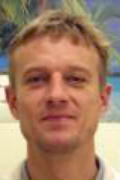
Associate Research Professor
Department of Physics and Astronomy
C-108 Physics Building
Stony Brook, NY 11794-3800
Phone: 631-632-8115
klaus.dehmelt@stonybrook.edu
Home Page
|
Research |
I worked in 1999, after receiving my M.Sc. with the HERA-B collaboration at the German National Accelerator Lab DESY on gas detectors before I moved over to the European Organization for Nuclear Research CERN to continue working on gas detectors with the COMPASS collaboration. Going back to grad school in 2002 I joined the PHENIX collaboration two years later as a graduate student at Florida Tech. After I received my Ph.D. I worked as a postdoc with the LCTPC collaboration at DESY again and eventually came to Stony Brook University into the RHI group as a research scientist in 2011. I was serving in 2014 as the run coordinator for the PHENIX experiment at the Relativistic Heavy Ion Collider RHIC at the Brookhaven National Laboratory.
Making the invisible visible and with it, investigating the structure of smallest entities is my fascination in this field. That's why my research interest is focused on detector development for high energy nuclear/particle collision experiments and the analysis of its outcome.
The nucleus is a rather complex formation of structures which again are having a complex and dynamic substructure ↠ atomic core → nucleons → quarks and gluons. How do all these objects know how and when and with whom to interact? That is what Quantum Chromo Dynamics QCD, the theory of strong interaction is trying to answer. For finding out if the theoretical description is correct or not we need to perceive these interactions, the scale on which is so tiny that it requires devices to tremendously magnify these interactions: powerful accelerators to provoke these interactions and large detector systems to observe the outcome of these interactions. To identify particles that are materializing out of these interactions and counting and ordering them with respect to their properties are the tools we can use to prove or disprove theories.
